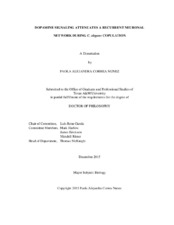| dc.description.abstract | Neuro-modulation of self-amplifying circuits drives the execution of behaviors to their appropriate context. These recursive networks are found throughout the Caenorhabditis elegans connectome, however the mechanism that fine-tunes reciprocal neural activity during complex behaviors is unknown. Here I dissect the cellular and molecular components involved in male copulation, a goal oriented behavior that entails initiation and termination under appropriate circumstances. The C. elegans mating circuit integrates sensory-motor cues resulting in copulatory spicule insertion into the hermaphrodite vulva. As the male tail presses against the hermaphrodite’s genitalia, cholinergic and glutamatergic reciprocal innervations of post-cloaca sensilla (PCS) neurons (PCA, PCB and PCC), hook neurons (HOA, HOB) and their post-synaptic sex muscles execute rhythmic spicule thrusts. These repetitive spicule movements continue until the male shifts off the vulva or genital penetration. However, the signaling mechanism that temporally and spatially restricts intromission attempts to vulva cues was unclear.
My results suggest that dopamine (DA) neuromodulation delimits spicule insertion attempts to the hermaphrodite vulva by dampening stimulus-independent spicule circuit activity. I found that upon vulval contact, DA signaling from male specific sensory neurons stimulates D2-like receptors, DOP-2 and DOP-3, to decrease cholinergic induced sex muscle contractions. Through pharmacology and targeted optogenetics I demonstrate that D2-like pathways act coincidentally, and as a consequence of cholinergic signaling, to reduce spicule intromission attempts with non-productive mating partners.
During spicule intromission attempts, DA up-regulates gap-junctions among PCB and a hook neuron to decrease self-amplifying PCS properties. Through forward genetics I isolated a missense mutation in an UNC-7L gap-junction isoform, which perturbs DOP-2 signaling in PCB and its electrical partner, HOA. Additional pharmacogenetic analysis suggests that the AVR-14 glutamate-gated channel partially introduces chloride ions into HOA to mediate DA downmodulation of the spicule circuit. Consistently, my analysis of the unc-7(rg396) allele indicates that when DOP-2 promotes UNC-7 electrical communication, AVR-14-mediated inhibitory signals pass from HOA to PCB. Consequently, the cholinergic PCB neuron is less receptive to stimulation by its recurrent glutamatergic synaptic partner, PCA. Furthermore, behavioral observations suggest that DA neuromodulation of UNC-7 ensures attenuation of recursive intromission attempts when the male disengages or is dislodged from the hermaphrodite genitalia | en |


